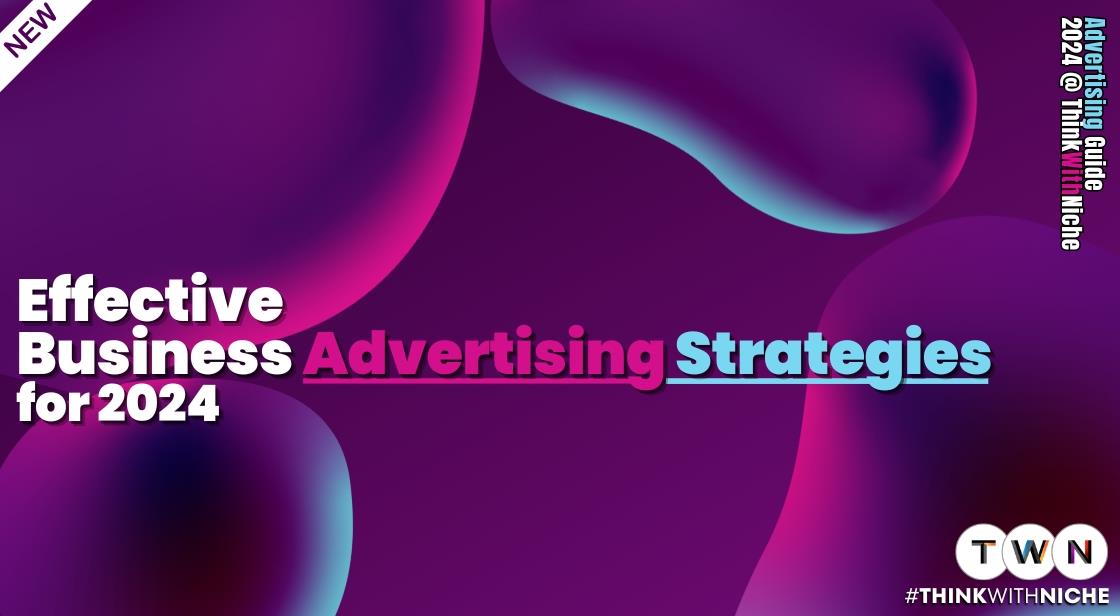Effective Business Advertising Strategies for 2024

Blog Post
2024 is a marketing maelstrom, and staying afloat demands radical evolution. Forget robotic pitches and generic campaigns – we're diving headfirst into a world of AI-powered personalization, heart-wrenching storytelling, and mind-bending metaverse experiences.
AI is whispering product desires before you even formulate them, crafting ads with pinpoint accuracy and boosting conversions by a staggering 80%. But it's not just cold logic – authentic narratives are the new currency, with brand loyalty soaring 23% when stories tug at our heartstrings.
And buckle up for the metaverse explosion: Gen Z yearns for virtual brand adventures, creating a playground for interactive campaigns and AR/VR showrooms that rewrite the rules of engagement. This is more than just marketing; it's reshaping our reality.
So, ditch the dusty playbook, embrace the extraordinary, and join us as we navigate this exhilarating new landscape.
Let's leave cookie-cutter campaigns in the rearview mirror and watch our brands soar in the face of the marketing maelstrom.
This article provides a comprehensive overview of top advertising strategies for 2024, equipping you with valuable insights and actionable steps to navigate the digital marketing terrain. Go forth and conquer the clicks!
Effective Business Advertising Strategies for 2024
Effective advertising isn't just about flashy visuals and catchy slogans. In today's hyper-connected world, it's a strategic dance of understanding your audience, engaging across diverse platforms, and measuring what truly matters: conversion. This article equips you with the latest and most powerful advertising strategies to cut through the noise and resonate with your ideal customers.
Top Advertising Strategies for 2024:
1. Dive Deeper into AI Personalization: 2024's Hyper-Targeted Advertising Arsenal
AI is no longer just a futuristic buzzword; it's revolutionizing the advertising landscape. Forget cookie-cutter campaigns - personalized ads fueled by AI are the new gold standard. But what does this mean in practice for 2024? Let's delve deeper into the exciting world of hyper-targeted advertising:
Beyond Demographics: A Symphony of Data Points
Move over age and gender! AI platforms tap into a vast orchestra of data, including:
-
Behavioral insights: Browsing history, purchase patterns, app usage, and even location data reveal real-time customer needs and preferences. Imagine showing travel ads to someone researching Paris hotels, or highlighting workout gear for those browsing fitness trackers.
-
Predictive analytics: AI algorithms anticipate future actions and desires, sending ads for products consumers might not even know they need yet. A pregnant woman searching for maternity clothes might see personalized promotions for baby toys or nursery gear.
-
Dynamic creative optimization: AI doesn't just target the right people; it tailors the message too. Headlines, visuals, and even calls to action adapt in real-time based on individual preferences and engagement. Picture shoe ads showcasing someone's favorite color or athletes they follow.
Real-World Examples: AI in Action
These aren't abstract concepts - leading brands are already reaping the rewards of AI personalization:
-
Spotify uses AI to recommend new music based on listening habits, creating personalized playlists that keep users engaged. Imagine shoe brands suggesting sneakers based on previous purchases and preferred styles.
-
Netflix leverages AI to personalize movie and show recommendations, boosting viewer satisfaction and keeping them glued to the platform. Imagine a clothing brand suggesting outfits based on user's online browsing habits and past purchases.
-
Nike implements AI-powered chatbots for personalized customer service, offering product recommendations and resolving queries in real-time. Imagine shoe stores providing virtual stylists powered by AI, recommending custom outfits and accessories based on individual preferences.
The Future of Personalization: Beyond Ads
The power of AI extends beyond just targeted ads. Brands can leverage it to:
-
Personalize product recommendations on websites and in-store displays. Imagine a shoe store automatically showcasing the right sizes and styles based on a customer's browsing history.
-
Craft dynamic email marketing campaigns with tailored offers and content. Imagine receiving shoe brand emails featuring products similar to those you recently viewed or saved.
-
Develop adaptive loyalty programs that reward individual preferences and purchase patterns. Imagine earning bonus points for buying your favorite shoe brand based on your purchase history.
2. Storytelling Techniques for 2024 and Beyond: Captivate Your Audience
In our information-saturated world, attention is a precious commodity. To stand out from the noise, businesses need to ditch the sales pitch and embrace the power of storytelling. Compelling narratives that tap into human emotions and connect with viewers on a deeper level are the key to unlocking audience engagement and brand loyalty. So, how can you weave a story that resonates in 2024 and beyond?
Go Beyond the Product: Show, Don't Tell
Forget bland product descriptions and generic features. Focus on showcasing the "why" behind your brand. Show how your product or service solves real-world problems, alleviates pain points, and empowers people to live better lives.
Examples:
-
A shoe brand highlights not just the technical specs of their sneakers, but the stories of athletes who achieve their goals while wearing them.
-
A financial services company instead of focusing on interest rates, tells the stories of real people who achieve financial stability through their services.
Embrace Authenticity and Vulnerability:
People crave relatability. Share your brand's origin story, its struggles and triumphs. Show the faces behind the company, not just polished marketing personas. By acknowledging your vulnerabilities, you invite genuine connection and trust.
Example:
-
A clothing brand features testimonials from everyday people wearing their clothes, not just professional models.
Leverage Multisensory Storytelling:
Don't be confined to text or static images. Utilize the power of video, interactive content, and even immersive experiences to engage multiple senses and create lasting memories.
Examples:
-
A travel company creates 360-degree virtual tours of destinations, giving viewers a taste of the experience before they book.
-
A furniture brand creates an interactive online showroom where users can customize and visualize their ideal living space.
Collaborate with Storytellers:
Partner with influencers, artists, or even customers who can tell your brand story from their unique perspectives. This adds authenticity and expands your reach to new audiences.
Example:
-
A beauty brand collaborates with makeup artists to create tutorials and stories showcasing their products in action.
Measure and Refine:
Storytelling is not a one-and-done effort. Track how your stories resonate with your audience. Analyze engagement metrics, social sentiment, and customer feedback to understand what works and what needs adjustment.
Remember:
-
Focus on emotions: Make your audience laugh, cry, or be inspired.
-
Keep it concise: Don't bog down your story with unnecessary details.
-
Call to action: Tell viewers what you want them to do after watching your story.
3. Mastering Metaverse Marketing in 2024: Dive into the Digital Vortex
The metaverse is no longer a futuristic mirage; it's a rapidly expanding digital frontier buzzing with opportunity. For brands with a pulse on the digital zeitgeist, it's time to immerse themselves in this virtual terrain and forge connections with tech-savvy audiences. But beyond the hype, how can you craft impactful metaverse marketing strategies in 2024? Let's delve into the exciting possibilities:
Beyond Filters and Games: Interactive Brand Experiences
Forget basic AR filters and one-off gamified campaigns. Think bigger! Construct immersive virtual destinations that showcase your brand's identity and engage users in meaningful ways:
-
Virtual showrooms and pop-up shops: Allow customers to explore products in 3D, customize them in real-time, and interact with virtual brand ambassadors. Think of a shoe brand creating a virtual skatepark where users can test sneakers on different terrains.
-
Metaverse events and conferences: Host product launches, workshops, and even industry conferences within the metaverse, fostering valuable brand interactions and community building. Imagine a fashion brand hosting a virtual runway show with interactive elements where viewers can influence styling choices.
-
Educational and storytelling experiences: Create immersive narratives that educate and entertain your audience, aligning with your brand values. A sports equipment brand could develop a virtual training camp where users learn from famous athletes in personalized sessions.
Harnessing AR's Hyperlocal Magic:
Augmented reality isn't just for cat ears and dancing emojis. Integrate hyperlocal, user-specific AR experiences into your strategies:
-
Interactive store windows: Imagine customers walking past a shoe store window and seeing personalized product recommendations projected onto their phone screens based on their preferences and browsing history.
-
Geolocation-based scavenger hunts: Design city-wide AR scavenger hunts that promote your brand and encourage exploration, offering rewards and discounts along the way.
-
Virtual product try-ons: Allow users to virtually try on clothes, shoes, or even makeup in real-time through their phone cameras, boosting online sales and reducing product returns.
Partnering with Metaverse Maestros:
Collaborate with metaverse platforms, game developers, and virtual influencers to amplify your reach and expertise:
-
Exclusive in-game activations: Partner with popular metaverse games to integrate your brand seamlessly, offering limited-edition items or hosting virtual events within the game's framework.
-
Virtual influencer collaborations: Leverage the power of virtual influencers who resonate with your target audience to promote your brand and products within the metaverse.
-
Metaverse brand ambassadors: Partner with real-life brand ambassadors who are active in the metaverse to create authentic content and experiences that connect with the digital community.
Remember:
-
Prioritize user experience: Focus on creating interactive, engaging, and meaningful experiences that benefit users, not just promote your brand.
-
Authenticity is key: Don't just slap your logo on everything. Integrate your brand values and identity seamlessly into the metaverse experiences.
-
Data and analytics are your friends: Track user behavior and engagement within the metaverse to refine your strategies and optimize your ROI.
4. Harnessing the Power of Influencer Marketing in 2024: Amplify Your Voice
In today's social media-fueled landscape, consumer trust often rests in the hands of everyday individuals, not faceless brands. This is where influencer marketing shines. Collaborating with the right voices can propel your message, build genuine connections, and unlock exponential reach. But beyond the celebrity faces, 2024's landscape demands a refined approach.
Let's explore how to leverage the influencer advantage in this ever-evolving ecosystem:
Beyond Followers: Aligning Values and Engagement
Forget chasing vanity metrics like follower count. Instead, seek partners whose values, personality, and content resonate with your brand and target audience. Authenticity reigns supreme; consumers can sniff out forced partnerships from a mile away.
Example:
An eco-conscious outdoor gear brand partnering with an environmental educator and micro-influencer who promotes sustainable travel is a perfect fit, resonating with both adventure seekers and environmentally conscious consumers.
Micro-Influencers: Your Niche Champions
While mega-influencers have undeniable reach, don't underestimate the power of micro-influencers. These niche experts boast hyper-engaged communities and deeper trust among their followers, leading to higher engagement and conversion rates.
Example:
A running shoe brand partnering with a local running coach with 10,000 engaged followers is likely to see higher engagement and purchase intent compared to a campaign featuring a celebrity with millions of followers but no connection to the running community.
Content Beyond the Pitch: Storytelling and Authenticity
Move beyond scripted endorsements and forced product placements. Empower your influencers to tell their own stories, showcasing how your product or service enhances their lives. Authentic storytelling fosters trust and resonates with viewers on a deeper level.
Example:
A fitness apparel brand providing yoga instructors with branded clothing to wear during their online classes, allowing them to organically integrate the product into their content and showcase its benefits in action.
Leveraging Diverse Platforms: Go Beyond Instagram
While Instagram remains a major player, explore the potential of other platforms like TikTok, Twitch, and even podcasts to reach niche communities and engage with specific demographics. Consider platform-specific content formats and trends to maximize impact.
Example:
A gaming peripheral brand partnering with Twitch streamers to showcase their products during gameplay or sponsoring esports tournaments reaches a highly engaged gaming audience directly on their preferred platform.
Data-Driven Optimization: Measure and Refine
Track campaign performance closely, analyzing follower engagement, reach, brand mentions, and even sales conversions. Use these insights to refine your influencer selection, content strategies, and platform focus for future campaigns.
Remember:
-
Transparency is key: Clearly disclose sponsored content to maintain audience trust.
-
Long-term partnerships: Go beyond one-off campaigns; build lasting relationships with influencers for deeper impact.
-
Community engagement: Encourage influencers to interact with their audience, creating a two-way dialogue around your brand.
5. Prioritize User-Generated Content (UGC)
The days of one-way brand broadcasts are over. In 2024, the most powerful marketing tool lies in the hands of your customers: User-Generated Content (UGC). By empowering your audience to be your storytellers, you unlock a treasure trove of authenticity, trust, and organic reach. Let's delve into the exciting world of UGC and how to leverage it to your advantage:
Beyond Hashtags: Cultivating a UGC Community
Forget throwing out a generic hashtag and hoping for the best. Foster a dedicated UGC community where customers feel valued and heard. Consider these strategies:
-
Host interactive contests and challenges: Encourage photo or video submissions related to your brand or product, offering exciting prizes for winners. Think of a shoe brand hosting a #MySneakerStyle challenge where users showcase their unique ways of rocking their sneakers.
-
Create co-creation campaigns: Work with your audience to design new products, craft marketing materials, or even develop brand stories. This gives them ownership and increases their investment in your brand.
-
Run social media takeovers: Let your most engaged fans take control of your accounts for a day, offering fresh perspectives and authentic content to your audience.
Showcasing UGC Magic: Amplifying Customer Voices
Don't just collect UGC; amplify it! Here's how to make it shine:
-
Feature the best content on your website, social media channels, and even marketing materials. This shows customers their contributions matter and encourages further participation.
-
Create dedicated UGC galleries or sections on your platforms. Highlight top content, user stories, and behind-the-scenes glimpses into the UGC community.
-
Respond to and engage with UGC creators. Show appreciation for their efforts, answer questions, and foster a sense of connection.
Building Trust and Advocacy: The UGC Advantage
By prioritizing UGC, you reap a multitude of benefits:
-
Enhanced brand authenticity: Real customer experiences resonate far deeper than polished marketing campaigns.
-
Increased social proof: Seeing others enjoying your product builds trust and encourages potential customers to buy.
-
Organic reach and engagement: UGC is shared and discussed naturally, expanding your reach beyond your own followers.
-
Valuable customer insights: Analyze UGC trends and feedback to understand your audience and improve your product and marketing strategies.
Remember:
-
Copyright and permissions: Always ask for permission before using customer-generated content.
-
Maintain quality standards: While authenticity is key, ensure UGC aligns with your brand values and maintains a professional image.
-
Celebrate diversity: Feature creators from different backgrounds and perspectives to reflect your audience and values.
6. Mastering Omnichannel Marketing in 2024
Gone are the days of siloed marketing campaigns confined to individual channels. Today's consumers navigate a seamless digital landscape, demanding consistent, personalized experiences across touchpoints.
This is where omnichannel marketing reigns supreme. It's the art of orchestrating a unified symphony of brand interactions, weaving a cohesive narrative that resonates across every platform, device, and customer journey.
But in 2024's dynamic landscape, what strategies ensure your brand rises above the digital cacophony?
Let's explore the secrets to omnichannel mastery:
Beyond Branding: Weaving a Cohesive Story
Your brand isn't just a logo and tagline; it's a captivating narrative woven across every touchpoint. Ensure your story remains consistent, whether on social media, in-store, or through email. Think of it like a thrilling choose-your-own-adventure book, where each channel offers a chapter in the brand's journey, seamlessly guiding customers towards the final act: conversion.
Example:
A travel company might run a social media campaign showcasing diverse destinations, followed by personalized email offers based on users' browsing history, culminating in a seamless online booking experience with live chat support.
From Screens to Stores: Blending Digital and Physical
Bridge the gap between online and offline worlds. Utilize technology like in-store beacons to trigger personalized offers on customers' phones, offer click-and-collect options, or host interactive virtual tours of physical stores. Make the journey between digital discovery and physical purchase frictionless and engaging.
Example:
A clothing brand might allow customers to virtually try on outfits in-store through AR mirrors, integrate Instagram shopping posts with physical displays, and offer loyalty points redeemable both online and offline.
Data Drives the Narrative: Personalization is Key
Leverage customer data to tailor experiences across channels. Recommend products based on past purchases, send targeted email campaigns based on browsing history, and personalize in-store greetings with customer preferences. Remember, data isn't just about numbers; it's about understanding and anticipating individual needs, making every interaction feel deeply personal.
Example:
A fitness app might suggest personalized workout routines based on wearables data, recommend recipes based on dietary preferences, and offer targeted discounts on relevant fitness gear or apparel.
Metrics Master: Measuring and Refining the Journey
Omnichannel success isn't a one-time win; it's a constant evolution. Track campaign performance across channels, analyze customer behavior at each touchpoint, and identify areas for improvement. Don't be afraid to experiment, adapt strategies based on insights, and optimize your omnichannel orchestra for the best possible performance.
Remember:
-
Seamless transitions: Make the journey between channels effortless and intuitive.
-
Consistent messaging: Maintain a unified brand voice and narrative across platforms.
-
Personalization reigns: Leverage data to tailor experiences and build deeper connections.
-
Data-driven decisions: Track performance, analyze, and adapt to optimize your strategy.
7. Optimizing Success with Measurement and Adaptation in 2024: Data-Driven Maestro
In the ever-evolving marketing landscape, intuition is a beautiful dance partner, but data is your unwavering compass. 2024 demands more than just launching campaigns and hoping for the best.
It's about harnessing the power of analytics to understand your audience, measure performance, and continuously adapt your strategies for optimal results.
Let's delve into the exciting world of data-driven marketing and how it can transform your campaigns:
Beyond Clicks: Embracing Multidimensional Metrics
Clicks and impressions are still valuable, but don't get lost in the vanity metrics trap. Employ sophisticated analytics tools that track deeper audience engagement, brand sentiment, customer lifetime value, and ROI across channels. Think of it like analyzing the entire symphony of your campaign, not just a single instrument.
Example:
A clothing brand might track not just website traffic but also social media mentions, product reviews, cart abandonment rates, and repeat purchase patterns to build a comprehensive picture of customer behavior and campaign effectiveness.
Experimentation is Key: A/B Testing Your Way to Success
Don't assume you have all the answers from the get-go. Embrace A/B testing to compare different ad copy, visuals, landing pages, and even entire campaign structures. This data-driven experimentation allows you to refine your approach, identify what resonates with your audience, and continuously optimize your efforts for maximum impact.
Example:
An email marketing campaign for a fitness app might A/B test different subject lines, call to action buttons, and personalized offers to see which elements drive the highest open rates and click-through conversions.
Real-Time Adjustments: The Agility Advantage
Data isn't just for post-campaign analysis; it's a real-time feedback loop. Utilize analytics dashboards and AI-powered insights to monitor campaign performance throughout its lifecycle. Make adjustments on the fly, optimize targeting based on audience behavior, and ensure your message remains relevant and engaging every step of the way.
Example:
A social media ad campaign for a travel company might use AI to automatically adjust bids based on real-time engagement, targeting users who show higher interest in specific destinations or travel dates.
Beyond Numbers: The Human Touch
Remember, data is a powerful tool, not a replacement for human intuition and creativity. Analyze the insights alongside your marketing expertise, industry knowledge, and understanding of your target audience. This nuanced approach ensures your data-driven decisions are strategically sound and emotionally resonant.
Remember:
-
Focus on actionable insights: Don't get bogged down in data overload; translate learnings into concrete actions to improve your strategies.
-
Invest in the right tools: Equip your team with robust analytics platforms and skilled personnel who can interpret and apply data effectively.
-
Embrace a culture of learning: Foster a data-driven environment where continuous experimentation and adaptation are encouraged, not feared.
8. Building Loyalty with Value-Driven Content in 2024
In today's information-saturated world, consumers are tired of the hard sell. They crave valuable insights, genuine connections, and content that solves their problems, not just promotes products.
This is where value-driven content takes center stage. By establishing your brand as a trusted resource and providing genuinely helpful information, you build long-term relationships and earn invaluable loyalty.
Let's explore how to craft content that resonates in 2024:
From Products to Insights: Education, Not Promotion
Shift your focus beyond product features and benefits. Offer educational content that addresses your audience's pain points, interests, and aspirations. Create informative blog posts, insightful webinars, and even interactive tutorials that showcase your expertise without being overtly salesy.
Example:
A fitness brand could publish articles on workout routines, healthy recipes, and injury prevention tips, establishing themselves as a trusted resource for health and wellness.
Thought Leadership: Sharing Your Expertise
Don't be afraid to delve deeper. Publish thought leadership pieces that address industry trends, challenges, and innovative solutions. This positions your brand as a leader in your field, attracting curious minds and potential customers who respect your knowledge and insights.
Example:
A financial services company could share research on market trends, economic forecasts, and personal finance strategies, solidifying their reputation as a reliable source of financial guidance.
Interactive Engagement: Beyond Text and Videos
Go beyond traditional formats. Experiment with interactive quizzes, polls, and even gamified content that actively engages your audience. This not only makes learning fun but also collects valuable data about their preferences and needs.
Example:
A fashion brand could create a fun quiz to help users discover their personal style, leading to personalized product recommendations and boosting engagement.
Building Community: Fostering Two-Way Dialogue
Remember, content is a conversation, not a monologue. Encourage comments, questions, and discussions on your platforms. Respond to audience feedback, address their concerns, and build a sense of community around your brand.
Example:
A beauty brand could host live Q&A sessions with makeup artists, inviting viewers to ask questions and participate in real-time discussions about skincare and makeup techniques.
Data-Driven Insights: Measuring Value, Not Just Views
Track the impact of your content beyond vanity metrics like views and shares. Analyze engagement metrics, website traffic, and even brand sentiment to understand what resonates and what needs tweaking. Use these insights to refine your content strategy and ensure it delivers genuine value to your audience.
Remember:
-
Prioritize quality over quantity: Focus on creating in-depth, informative content that truly benefits your audience.
-
Authenticity is key: Share genuine insights and passion, not just marketing messages.
-
Consistency matters: Establish a regular content schedule to build trust and keep your audience engaged.
-
Adapt and refine: Analyze your data, respond to feedback, and continuously improve your content strategy.
9. Weaving Sustainability and Social Responsibility into Your 2024 Brand Narrative
Cultivating Green Loyalty:
In a world grappling with ecological challenges and social inequities, consumer choices are increasingly guided by conscience. Today's audiences seek brands that align with their values of sustainability and responsible practices.
This makes embracing sustainability and social responsibility not just a trendy add-on, but a crucial element for building genuine loyalty and long-term brand success in 2024.
Let's explore how to weave these values into the fabric of your brand:
Beyond Greenwashing: Authentically Integrating Sustainability
Move beyond token gestures and greenwashing attempts. Focus on genuine integration of sustainability practices across your entire operation. Consider elements like:
-
Ethical sourcing: Choose suppliers committed to fair labor practices, environmental protection, and responsible material sourcing.
-
Eco-friendly packaging: Opt for biodegradable, recycled, or reusable packaging materials to minimize environmental impact.
-
Sustainable production: Implement energy-efficient practices, reduce waste in your manufacturing process, and explore renewable energy sources.
Example:
An apparel brand partners with organic cotton farmers, uses recycled polyester in its clothing, and offers customers the option to return packaging for reuse.
Championing Social Good: Aligning with Causes You Care About
Extend your commitment beyond environmental issues. Choose impactful social causes that resonate with your brand and values. Consider:
-
Community initiatives: Partner with local organizations working on education, poverty alleviation, or environmental preservation.
-
Diversity and inclusion: Promote inclusivity within your company and showcase diverse voices in your marketing campaigns.
-
Philanthropic partnerships: Support charities aligning with your chosen cause and encourage customer participation through donation drives or matching programs.
Example:
A food company partners with a food bank to donate excess produce, promotes diverse representation in its advertising campaigns, and supports initiatives empowering women in agriculture.
Transparency is Key: Openly Communicating Your Efforts
Don't be a silent hero. Share your sustainability and social responsibility initiatives openly and transparently. Show your audience the steps you're taking, the challenges you face, and the progress you're making. Consider:
-
Impact reports: Publish regular reports outlining your environmental and social impact, showcasing measurable results and ongoing efforts.
-
Behind-the-scenes content: Share stories of your ethical sourcing partners, community projects, and the individuals behind your sustainable practices.
-
Transparent branding: Clearly communicate your values and commitments within your brand messaging and marketing materials.
Example:
A beverage company publishes annual sustainability reports detailing their water conservation efforts, carbon footprint reduction goals, and partnership with a local water preservation organization.
Remember:
-
Authenticity matters: Consumers can sniff out greenwashing from a mile away. Focus on genuine commitment and action, not just marketing hype.
-
Engage your audience: Make sustainability and social responsibility a two-way conversation. Invite feedback, address concerns, and encourage customer participation in your initiatives.
-
Continuous improvement: Sustainability is a journey, not a destination. Track your progress, identify areas for improvement, and set ambitious but achievable goals.
10. Cultivating Customer Loyalty Through Experience-Driven Marketing in 2024
Beyond the Click:
In today's hyper-competitive marketplace, a captivating ad campaign is merely the opening act. The true measure of brand success lies in the entire customer journey: a seamless symphony of interactions, tailored experiences, and unwavering support.
This is where experience-driven marketing takes center stage, transforming fleeting transactions into lasting loyalty in 2024.
Let's explore how to orchestrate an unforgettable customer journey:
From Friction to Frictionless: Streamlining the Purchase Path
Every touchpoint, from browsing your website to receiving the product, should be effortless and intuitive. Invest in user-friendly interfaces, streamline checkout processes, and offer multiple payment options. Consider:
-
Personalized product recommendations: Leverage data to suggest relevant items based on browsing history, preferences, and past purchases.
-
Omnichannel integration: Ensure a consistent experience across platforms, whether online, in-store, or even through mobile apps.
-
Live chat and chatbot support: Offer readily available assistance when customers face challenges or have questions.
Example:
An online shoe store implements a virtual try-on feature, allows customers to save favorite items for later, and offers express checkout with stored payment information.
Post-Purchase Delights: Nurturing Relationships Beyond the Sale
The journey doesn't end with the checkout. Cultivate lasting connections through personalized post-purchase communication:
-
Welcome emails and thank-you notes: Express appreciation for the purchase and introduce new products or services relevant to their interests.
-
Interactive feedback opportunities: Encourage customers to share their experiences through surveys, reviews, or social media engagements.
-
Loyalty programs and reward systems: Recognize repeat customers and incentivize further purchases with exclusive deals, early access to new products, or personalized recommendations.
Example:
A coffee subscription service sends personalized brewing tips and recipes based on the customer's chosen blend, offers reward points for referring friends, and hosts exclusive online tasting events.
Feedback as Fuel: Continuously Refining the Experience
Actively solicit and analyze customer feedback to identify areas for improvement. Leverage data gathered through surveys, reviews, and social media interactions to understand their needs and optimize your offerings:
-
Respond to reviews and address concerns promptly and professionally.
-
Analyze feedback trends and adjust product features, communication strategies, and customer service protocols accordingly.
-
A/B test different touchpoints to identify the most effective and user-friendly interactions.
Example:
A fitness app constantly updates its workout routines based on user feedback, introduces new features requested by the community, and personalizes training plans based on individual goals and preferences.
Remember:
-
Personalization is key: Tailor experiences to individual needs and preferences to foster deeper connections.
-
Frictionless interactions: Make every touchpoint effortless and enjoyable, from browsing to post-purchase engagement.
-
Active listening: Embrace feedback and continuously refine your processes to meet evolving customer expectations.
-
Metrics matter: Track key performance indicators to measure the effectiveness of your efforts and identify areas for optimization.
Conclusion:
In 2024, the most effective advertising strategies are those that connect with customers on an emotional level, personalize experiences, and embrace the ever-evolving digital landscape.
By implementing these tactics, you can cut through the noise, build trust, and drive your business towards sustainable growth.
"Remember, successful advertising is about more than just clicks; it's about building genuine relationships with your audience and delivering on your brand promise."
You May Like
EDITOR’S CHOICE












